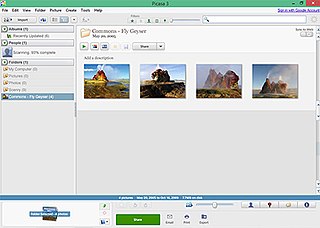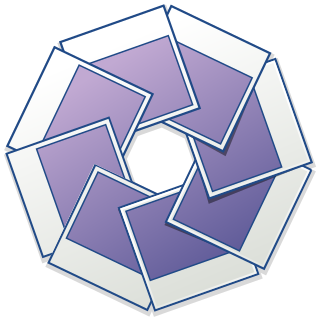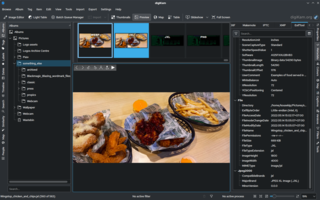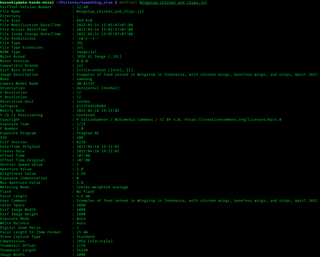
Picasa was a cross-platform image organizer and image viewer for organizing and editing digital photos, integrated with a now defunct photo-sharing website, originally created by a company named Lifescape in 2002. "Picasa" is a blend of the name of Spanish painter Pablo Picasso, the phrase mi casa and "pic" for pictures.
Digital Negative (DNG) is a patented, open, lossless raw image format developed by Adobe and used for digital photography. Adobe's license allows use without cost on the condition that the licensee prominently displays text saying it is licensed from Adobe in source and documentation, and that the license may be revoked if the licensee brings any patent action against Adobe or its affiliates related to the reading or writing of files that comply with the DNG Specification. It was launched on September 27, 2004. The launch was accompanied by the first version of the DNG specification, plus various products, including a free-of-charge DNG converter utility. All Adobe photo manipulation software released since the launch supports DNG.

F-Spot is a slowly maintained image organizer, designed to provide personal photo management for the GNOME desktop environment. The name is a play on the word F-Stop.

Gwenview is an image viewer for Unix-like systems and is released as part of the KDE Applications bundle. The current maintainer is Aurélien Gâteau. The word "Gwen" means "white" in the Breton language and is commonly used as a first name.
The Extensible Metadata Platform (XMP) is an ISO standard, originally created by Adobe Systems Inc., for the creation, processing and interchange of standardized and custom metadata for digital documents and data sets.

XnView is an image organizer and general-purpose file manager used for viewing, converting, organizing and editing raster images, as well as general purpose file management. It comes with built-in hex inspection, batch renaming and screen capture tools. It is licensed as freeware for private, educational and non-profit uses. For other uses, it is licensed as commercial software.
A camera raw image file contains unprocessed or minimally processed data from the image sensor of either a digital camera, a motion picture film scanner, or other image scanner. Raw files are named so because they are not yet processed and therefore are not ready to be printed, viewed or edited with a bitmap graphics editor. Normally, the image is processed by a raw converter in a wide-gamut internal color space where precise adjustments can be made before conversion to a viewable file format such as JPEG or PNG for storage, printing, or further manipulation. There are dozens of raw formats in use by different manufacturers of digital image capture equipment.

Adobe Bridge is a free digital asset management app made by Adobe Inc. and first released with Adobe Creative Suite 2. It is a mandatory component of Adobe Creative Suite, Adobe eLearning Suite, Adobe Technical Communication Suite and Adobe Photoshop CS2 through CS6. Starting with Creative Cloud, however, it has become an optional component downloaded via Creative Cloud subscription.

Windows Photo Gallery is a discontinued image organizer, photo editor and photo sharing program. It is a part of Microsoft's Windows Essentials software suite. The product has been unavailable for download since January 10, 2017, as the Windows Essentials line of products have been discontinued.

An image organizer or image management application is application software for organising digital images. It is a kind of desktop organizer software application.
Microsoft Digital Image was a digital image editing program created by Microsoft. It was a successor to Microsoft Picture It!
KPhotoAlbum is an image viewer and organizer for Unix-like systems created and maintained by Jesper K. Pedersen. The core philosophy behind its creation was that it should be easy for users to annotate images and videos taken with a digital camera. Users can search for images based on those annotations and use the results in a variety of ways. Features include slideshows, annotation, KIPI plugin support for manipulating images, and Boolean searches.
Windows Imaging Component (WIC) is a COM-based imaging codec framework introduced in Windows Vista (and later available in Windows XP Service Pack 3) for working with and processing digital images and image metadata.

FastPictureViewer is a freemium image viewer for Windows XP and later. Its aim is to facilitate quick review, rating and annotation of large quantities of digital images in the early steps of the digital workflow, with an emphasis on simplicity and speed. As an app with a freemium license, a basic version is available cost-free for personal, non-profit or educational uses, while a commercial license is required for the professional version with additional features. The basic version starts as a full version trial.

ExifTool is a free and open-source software program for reading, writing, and manipulating image, audio, video, and PDF metadata. It is platform independent, available as both a Perl library (Image::ExifTool) and command-line application. ExifTool is commonly incorporated into different types of digital workflows and supports many types of metadata including Exif, IPTC, XMP, JFIF, GeoTIFF, ICC Profile, Photoshop IRB, FlashPix, AFCP and ID3, as well as the manufacturer-specific metadata formats of many digital cameras.
Sidecar files, also known as buddy files or connected files, are computer files that store data which is not supported by the format of a source file.
In digital photography, the Camera Image File Format (CIFF) file format is a raw image format designed by Canon, and also used as a container format to store metadata in APP0 of JPEG images. Its specification was released on February 12, 1997.
KDE Image Plugin Interface is an API that allows creation of application-independent image processing plugins in the KDE project.

Darktable is a free and open-source photography application program and raw developer. Rather than being a raster graphics editor like Adobe Photoshop or GIMP, it comprises a subset of image editing operations specifically aimed at non-destructive raw image post-production. It is primarily focused on improving a photographer's workflow by facilitating the handling of large numbers of images. It is freely available in versions tailored for most major Linux distributions, macOS, Solaris and Windows and is released under the GPL-3.0-or-later.
AV1 Image File Format (AVIF) is an open, royalty-free image file format specification for storing images or image sequences compressed with AV1 in the HEIF container format. It competes with HEIC, which uses the same container format built upon ISOBMFF, but HEVC for compression. Version 1.0.0 of the AVIF specification was finalized in February 2019.








